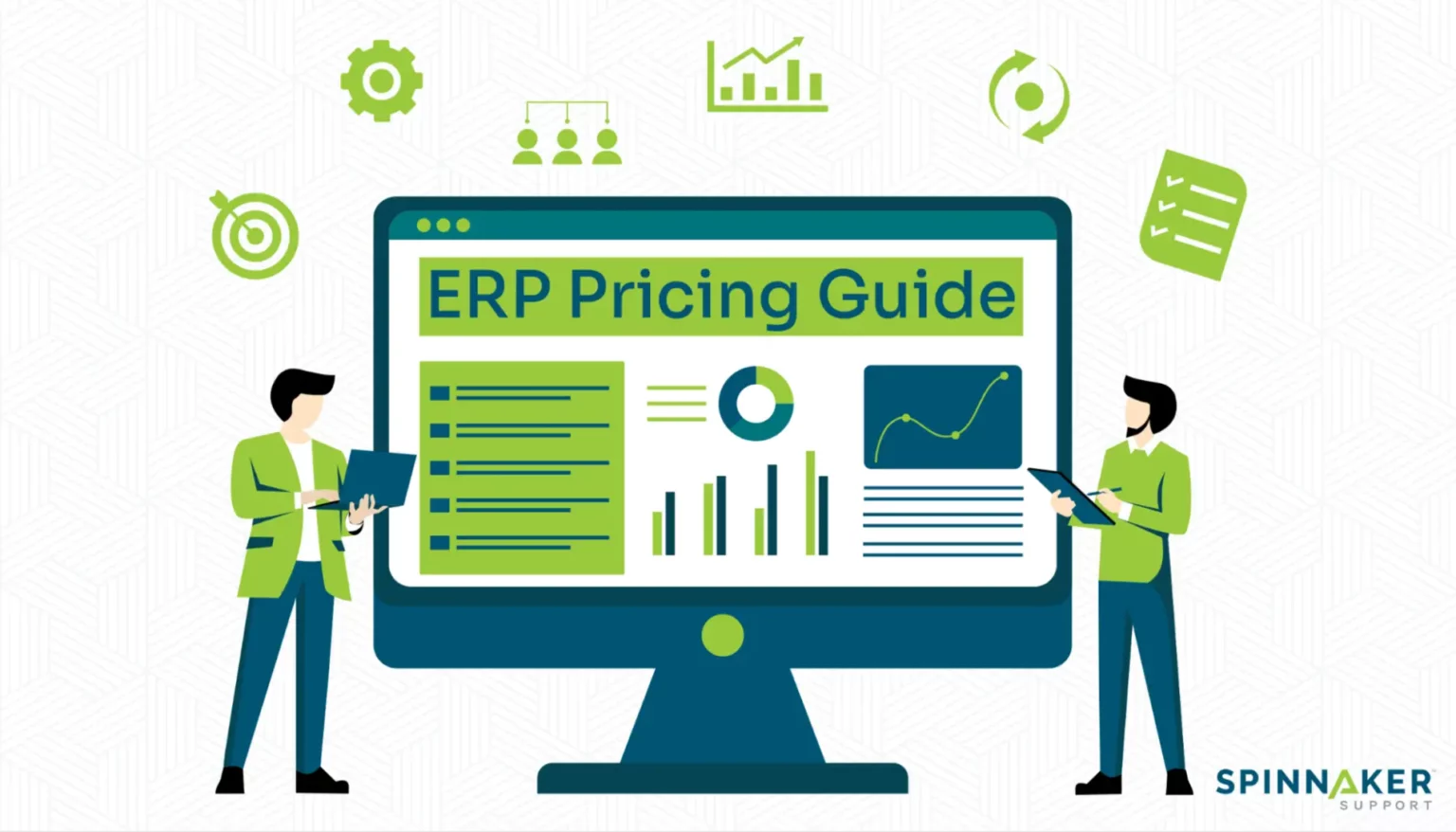
Determining the cost of an Enterprise Resource Planning (ERP) solution is an important step in the ERP implementation process. However, the total cost of ownership (TCO) isn’t a straightforward calculation.
Pricing structures for ERP solutions vary based on factors such as the business size, the scope of functionality required, and the deployment model you chose. Additional considerations include licensing fees, customization requirements, ongoing maintenance and support costs, and potential integration expenses.
Understanding the factors that influence ERP pricing can help organizations make informed decisions.
In this article, we’ll share our thoughts on how you can justify the expense of ERP systems and explain the structure of ERP prices. We’ll also share how support costs for ERP systems can be your highest expense and how you can reduce them significantly with third-party support.
How do you justify the investment in ERP software?
As a CFO, this could be your first action item.
You need a well-structured argument anchored in tangible and intangible benefits to justify the cost of an ERP. To make a compelling case, you can conduct a cost-benefit analysis demonstrating a favorable ROI over a specific time frame.
You can also showcase how the ERP can reduce manual tasks, improve data accuracy, and speed up processes. Make it clear that ERP isn’t an IT investment but a strategic enabler.
The ERP market is expected to reach a staggering $101 billion by 2026. You don’t want to delay and let other companies reap the benefits.

Look beyond the initial implementation costs and discuss the TCO. Point out future savings through more efficient processes, reduced human resources, and lower maintenance costs.
This is where you can consider third-party support services, like those offered by Spinnaker Support, as we can significantly lower ongoing operational costs.
By addressing these points, you can build a narrative to justify the significant investment that an ERP implementation entails.
What is the cost of an ERP implementation?
Putting up an exact cost for an ERP system is difficult, but it can go anywhere from $1,740 for small businesses to $9,330 for enterprises.
These figures are estimates.
Software vendors typically don’t display ERP prices on their websites. That’s because the cost of an ERP system is based on a range of measures like the kind of business processes and the size and complexity of their operations.
In the next sections, we’ll share the approximate cost of ERP for three business tiers.
Small businesses
Small businesses with $1 million in annual revenue can expect to pay $1,740 to $4,620 monthly. That’s an annual payment of $20,880 to $55,440. Note this doesn’t include training, implementation, or user costs.
However, since the number of users in a small business won’t be huge, the per-user cost can be low. Plus, there may be fewer requirements for customizations and integrations, so pricing can be affordable here.
Mid to large-size businesses
Mid to large-size businesses with annual revenue of $50 to $100 million can ballpark the ERP price at $4,620 and $5,160 monthly.
Significant factors that can raise the ERP prices are the number of users, customizations, and integrations.
Enterprises
Enterprises that earn $100 million annually can expect to pay an average of $9,330 per month in ERP pricing plans. Of course, enterprises will be paying substantial upfront costs, but they can restrict the number of users and have only the key stakeholders use the system. That can reduce per-user costs and make enterprise ERP pricing strategically affordable.
We recommend contacting ERP vendors directly and discussing your specific needs with them if you want to obtain accurate pricing information. They’ll be able to provide a customized quote based on your requirements.
Additionally, it’s essential to understand that ERP prices can vary between vendors. Even within the same vendor, the prices depend on licensing models, additional services, and ongoing maintenance and support costs.
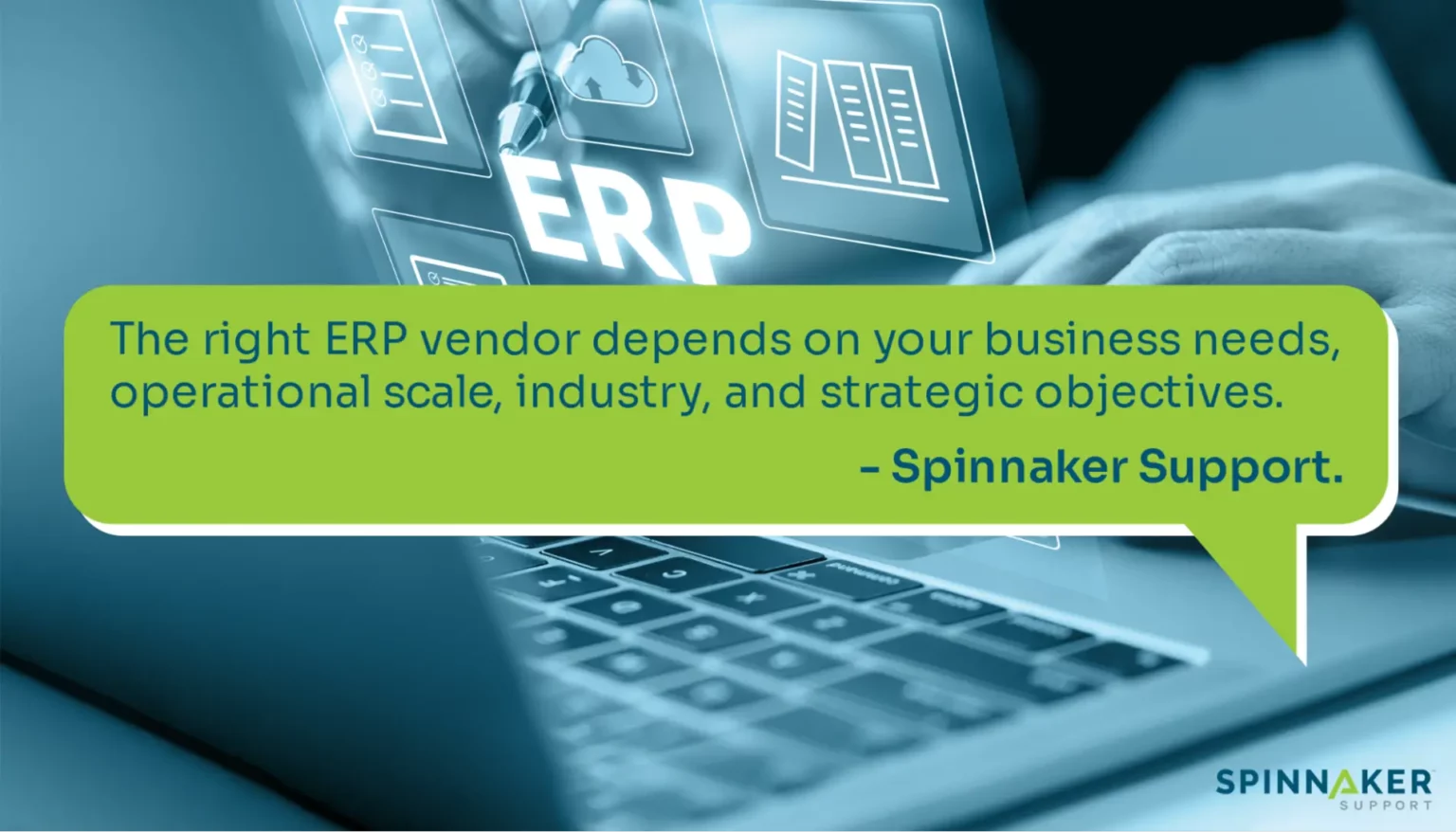
Therefore, comparing and evaluating multiple options is advisable before deciding on an ERP system.
While choosing a vendor, you must know the factors influencing ERP prices.
Factors that impact ERP prices
The TCO for an ERP system can vary widely based on several factors.
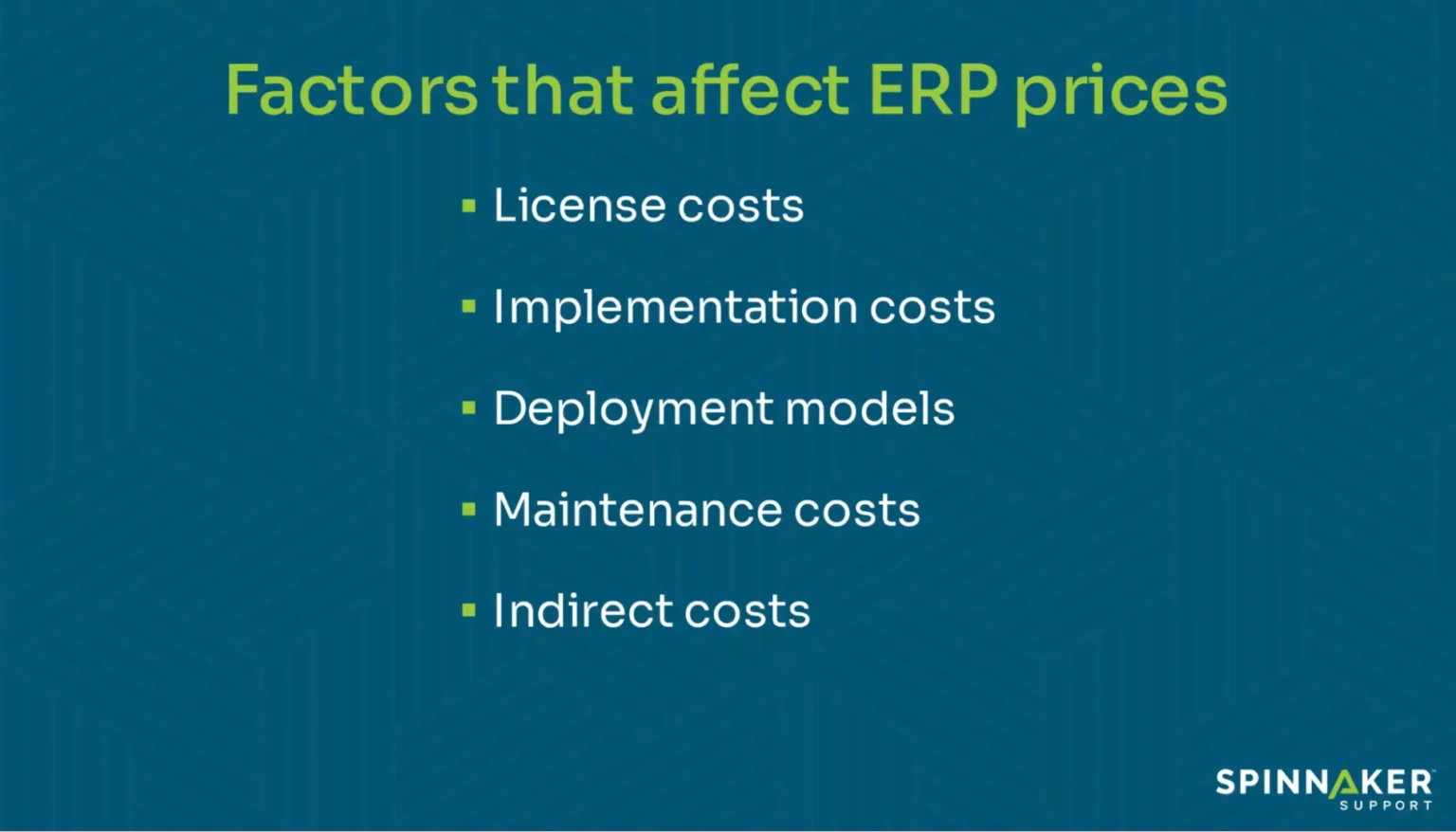
Here’s a breakdown of the factors that affect ERP prices.
1. License cost
These are upfront fees but include variable costs based on modules and users.
Most ERP software includes human resources, finance, and inventory management modules. However, specialized modules such as customer relationship management (CRM), supply chain management (SCM), or advanced analytics will add to the overall cost. The more modules you add, the higher the price tag.
ERP vendors usually offer tiered pricing models based on the number of users.
2. Implementation cost
Installation costs are underrated and can often go over budget, so pay special attention to these. Factors that can affect these costs include the following.
Implementation strategy
The approach to implement an ERP system — whether a phased rollout, a pilot/parallel run, or a “big bang” approach where everything is rolled out simultaneously — will influence the cost. Each strategy has its risks and timelines, impacting the overall cost due to varying consultation and support requirements.
Consultation
Consultation fees for ERP prices are common in the industry because they provide value-added services. These fees cover the cost of:
- Expert guidance in choosing the right ERP system
- Time and effort put in by consultants to analyze the client’s business operations
- Assistance in negotiating with ERP vendors to get the best price and terms for the client
- The complexity of the client’s requirements and the reputation
Customization
ERP systems can be customized to align with unique business functions, workflows, and requirements. However, customizing an ERP system requires additional work from the software provider or an implementation partner, which incurs additional costs.
Data migration
Transferring data from your existing systems to the new ERP often involves extra expenses, from cleansing the data to mapping it accurately into the new system.
Add-ons
Add-on modules could include third-party tools for business intelligence, advanced reporting, or specific integrations with other software.
3. Deployment model: Perpetual or subscription?
Choosing between your ERP system’s subscription and perpetual licensing options is critical, impacting immediate cash flow and the TCO over the long term.
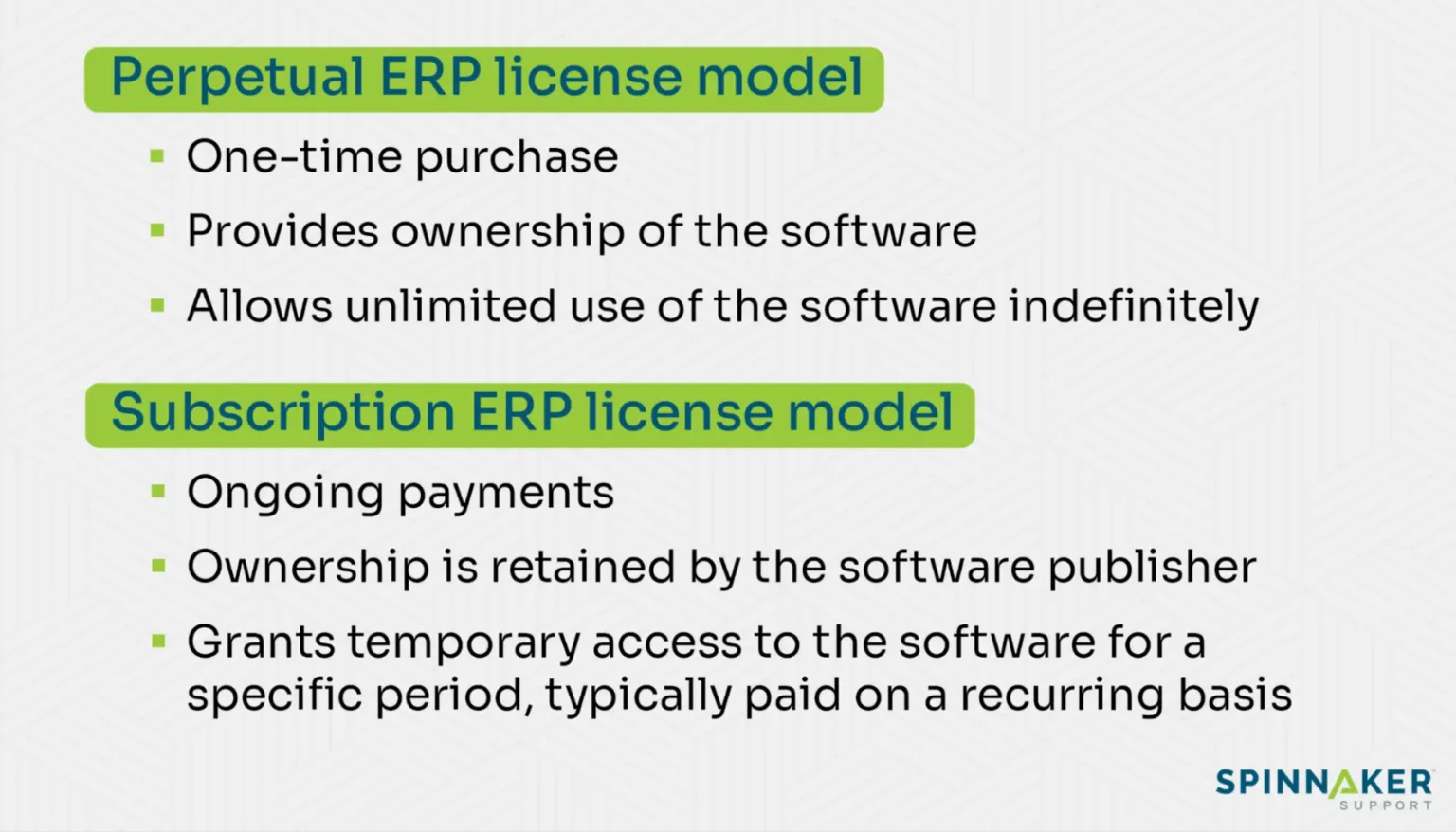
A subscription model, often synonymous with cloud-based solutions, offers:
- Lower upfront costs
- Quicker implementation
- Easier scalability
- Flexibility to switch vendors or modules as your needs evolve
- Operational expenditure (OPEX) budgeting (since you’re “renting” out the software)
However, the ongoing subscription fees can add up over time.
The subscription model may be more attractive for businesses seeking agility and minimal initial investment (even if it means a potentially higher TCO).
On the other hand, a perpetual license, usually associated with on-premise deployments, involves a significant initial capital expenditure. The software is yours to keep, often making this model more economical in the long run, especially if you plan to use the ERP system for many years.
However, you’ll likely face additional costs for:
- The initial infrastructure implementation
- Maintenance
- Support
- Any future upgrades
A perpetual license may offer a lower TCO for a stable, established company planning to leverage the ERP for an extended period. Making the correct choice hinges on your organization’s financial strategy, scalability needs, and risk tolerance.
4. Maintenance cost
Often called support costs — these include a percentage of the license cost. Services include software updates and technical assistance.
Publisher support is expensive and increases by 2 to 4% every year. For example, SAP is expected to raise support costs by 5% in 2024.
You can opt for a third-party support (3PS) provider, like Spinnaker Support, to save on these costs. We can help you reduce support costs by 60% while supporting end-of-life SAP and Oracle products.
5. Indirect costs
Some hidden costs can affect ERP prices. These include:
- Productivity loss: Productivity loss can occur when employees are not adequately trained or when disruptions occur during the transition period. Effective change management is necessary to help employees adapt to new processes and technologies.
- Negotiation skills: The price quoted by an ERP vendor is often negotiable. Your ability to negotiate effectively can lead to significant cost savings by securing a lower price or getting additional modules or services included at no extra charge.
How can you keep ERP prices low?
If you opt for on-prem ERP solutions, your support costs can be 18 to 25% of the license cost.
Additionally, most publishers increase maintenance costs by 2 to 4% annually. That means after three to five years, your total support cost can exceed the original license cost.
While you can’t avoid the high license fees, you can reduce the support costs with third-party support from Spinnaker Support.
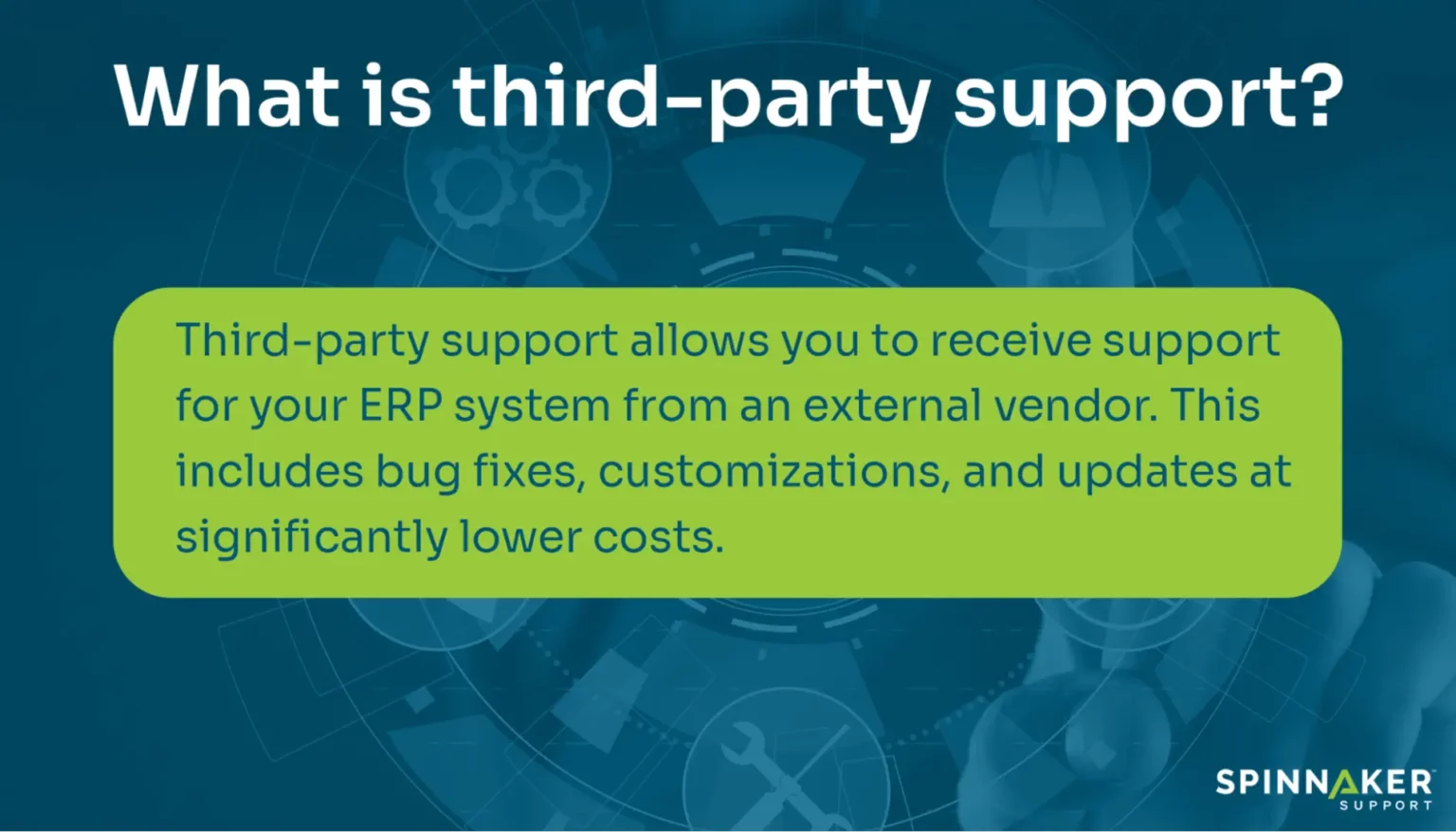
3PS can help you reduce software annual maintenance fees by as much as 50%.
For example, Edinburgh airport saw savings of about 60% in support costs after switching to our 3PS services. You can optimize your spending with 3PS providers like Spinnaker Support.
Spinnaker Support offers 3PS for Oracle, SAP, JD Edwards, and Microsoft. We’ve worked with 1,300+ clients like Mitsubishi, Toyota, Johns Hopkins University, and Penn State.
Our 3PS includes the following offerings.
Experienced team
Our team of engineers has an average of 20 years of experience, and we hire engineers with deep product knowledge. Once you start working with us, we’ll allocate a multi-disciplinary team to closely work with your IT team and managers. They become an extension of your IT team.
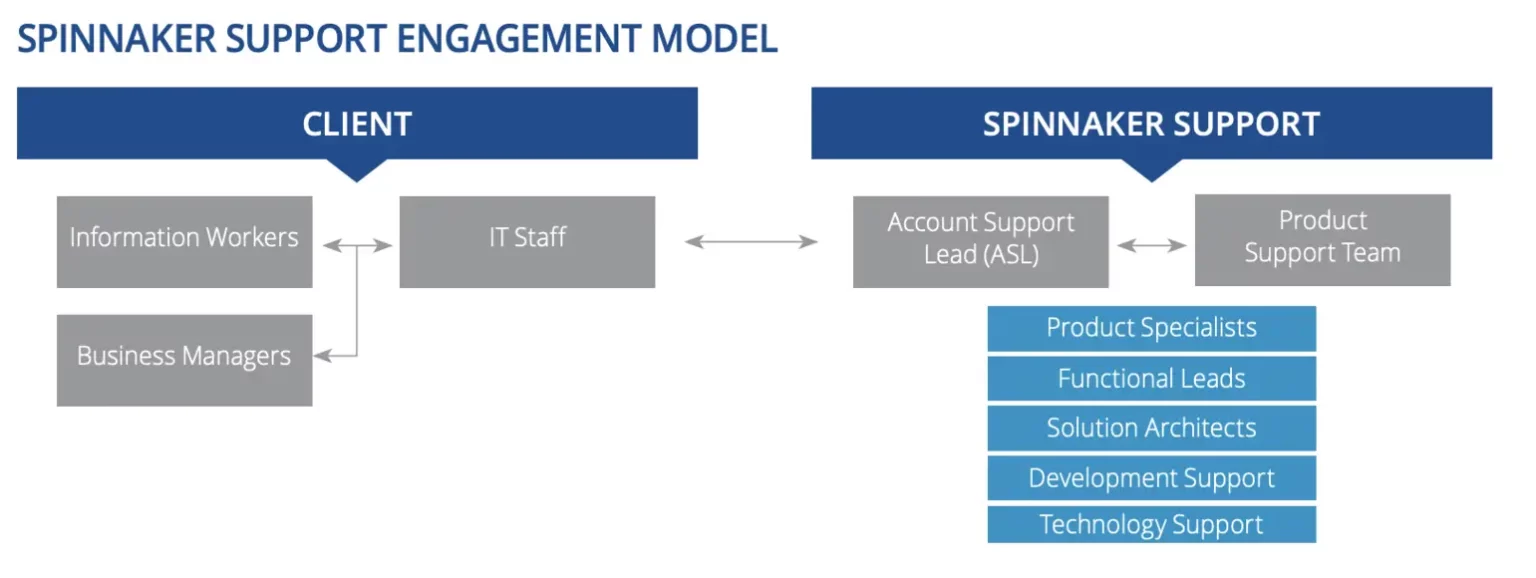
Plus, our team is stable—we have a retention rate of 95%. Most engineers have stuck around for over a decade. This helps us understand and retain your unique needs.
Responsive engineers
Most publishers want you to self-serve. You have to diagnose the problem and find a fix from their knowledge bases. If you raise a ticket, their response time is one business day (which we believe is a lot when you want to solve critical IT issues).
We do it differently. We respond within 5 to 15 minutes of you raising a ticket, and our Level 2 and 3 engineers offer a personalized service. If the issue needs an escalation, we involve a Level 4 engineer to resolve it.
Interoperability and custom code support
Most software publishers don’t provide custom code and interoperability support. That’s because it can be complex, time-consuming, and requires a deeper understanding of each customer’s unique environment.
However, at Spinnaker Support, we support standard code, custom code, and integrations. For example, Lexmark didn’t receive custom code and interoperability support under their standard Oracle support. After switching to Spinnaker Support, they received both support services.
Global tax and regulatory compliance (GTRC)
Under GTRC services, Spinnaker Support monitors updates to identify what you need to be compliant. We advise you to implement solutions to mitigate regulatory risks. Our updates cover federal and local reporting changes.
Genus was worried about their GTRC problems related to their international operations. As a solution, Spinnaker Support engaged with Genus every month to track and resolve all existing issues successfully.
Security hardening
Spinnaker Support adheres to a Seven-Point Security Solution, which provides unified security across your application, middleware, database, and operating system layers.
With CIS and STIG industry-standard robust IT security benchmarks, we offer a secure environment and hardened systems to pass audits and penetration testing.
Advisory
If you have any queries about roadmap planning or general inquiries, our team is happy to help answer them.
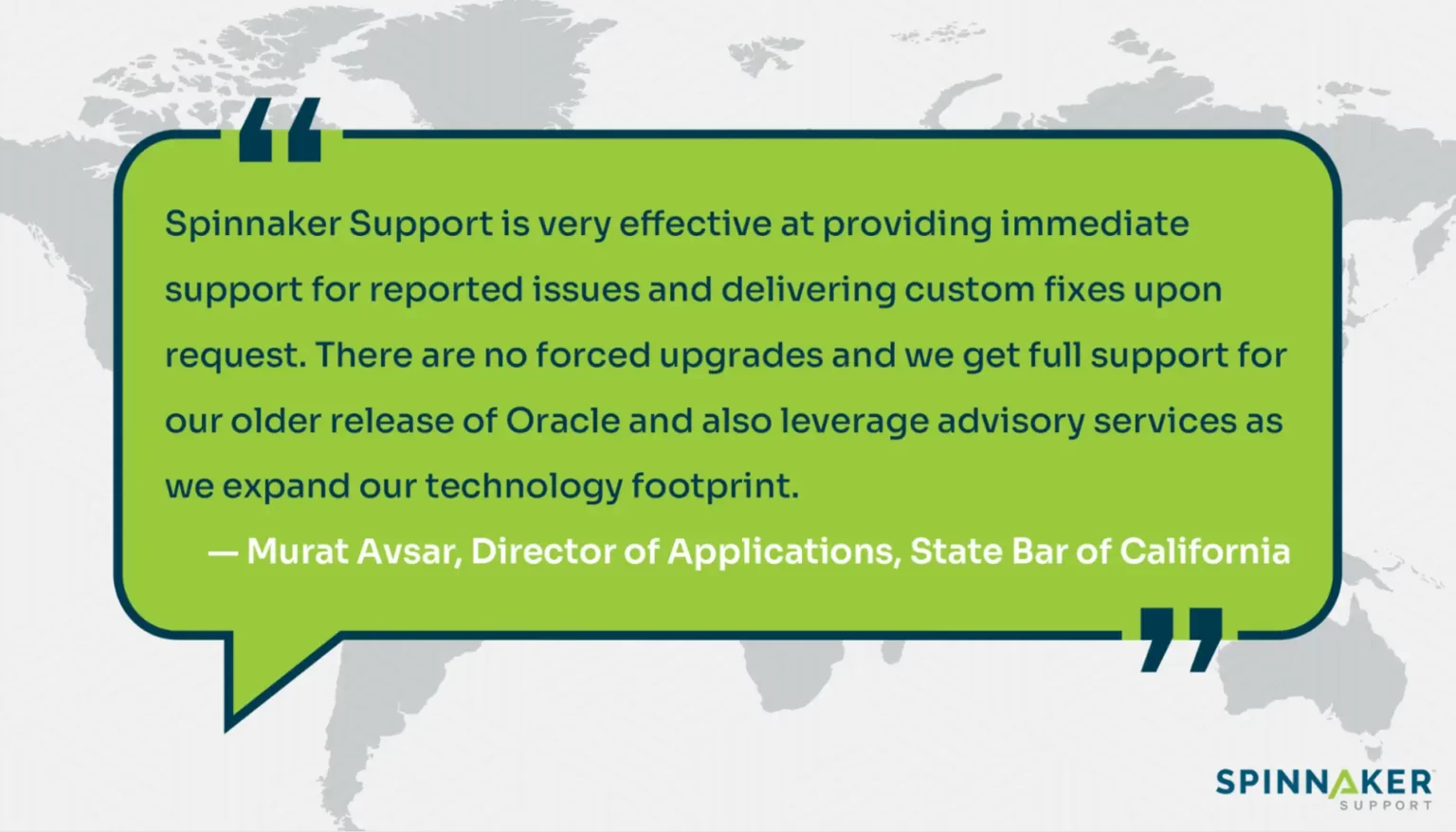
At Spinnaker Support, we provide advisory services on many topics including:
- Interoperability
- Performance improvement
- Roadmap planning
- Cloud migration
- Upgrade support
- Installation support
- System administration
- Virtualization
- License Compliance Assurance and Audit Defense
Maximize your ERP investment
The price of an ERP solution varies depending on various factors, such as the scale of the organization, functionality required, customization needs, and implementation complexity.
Additionally, it is essential to consider long-term costs, including maintenance and upgrades, to ensure a successful ERP implementation.
By partnering with a reliable third-party support provider like Spinnaker Support, businesses can access expert guidance, troubleshooting, and cost-effective solutions, which can help optimize their ERP investment and minimize long-term expenses.
Contact us today to discuss your third-party support needs.


